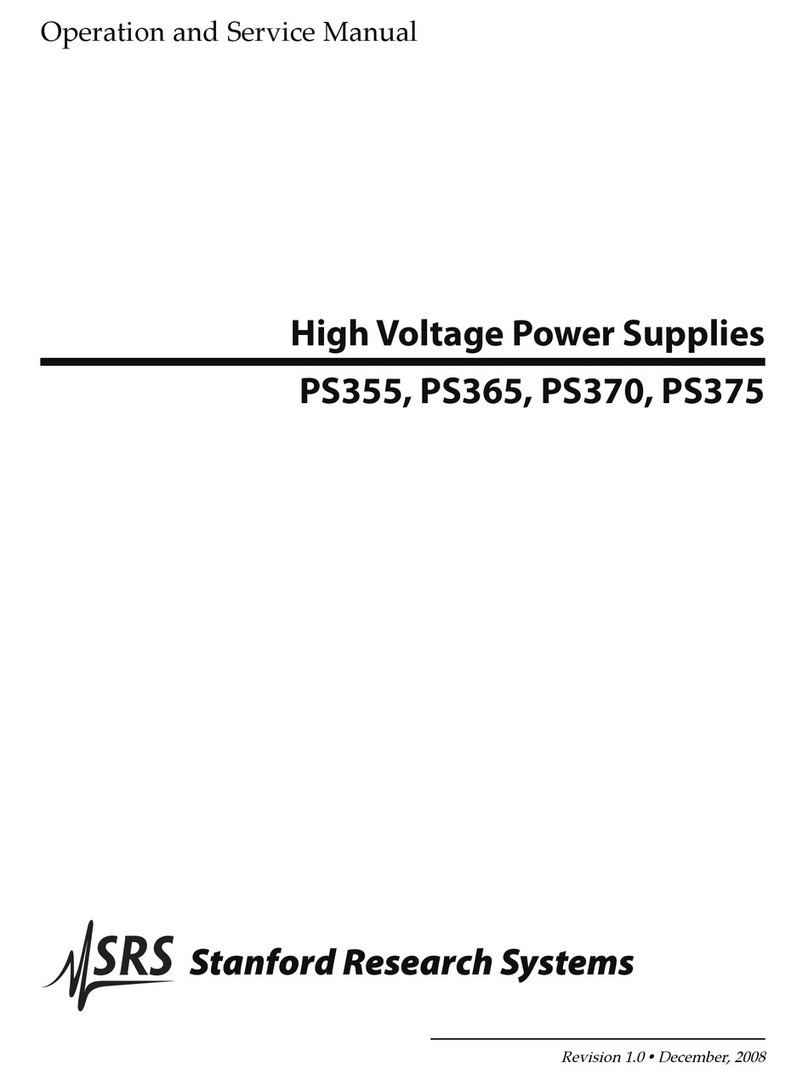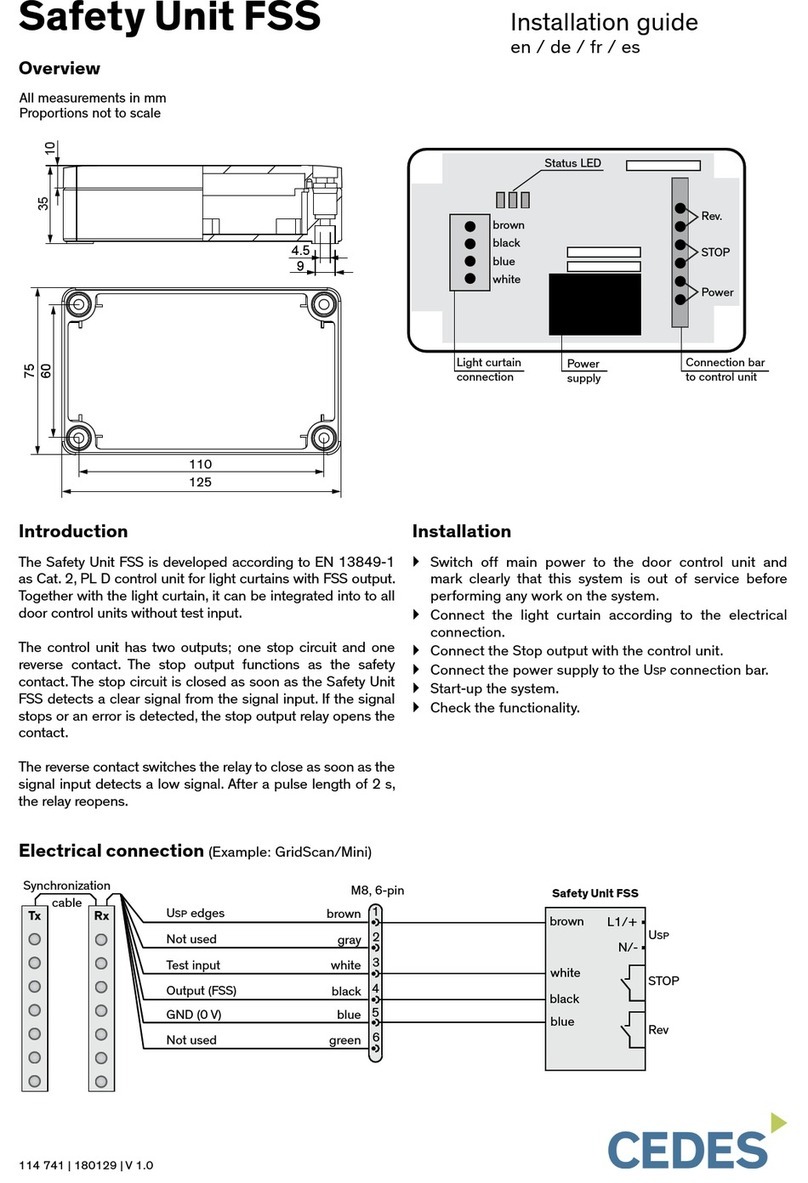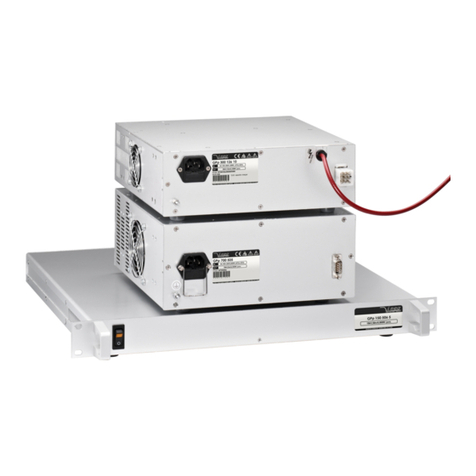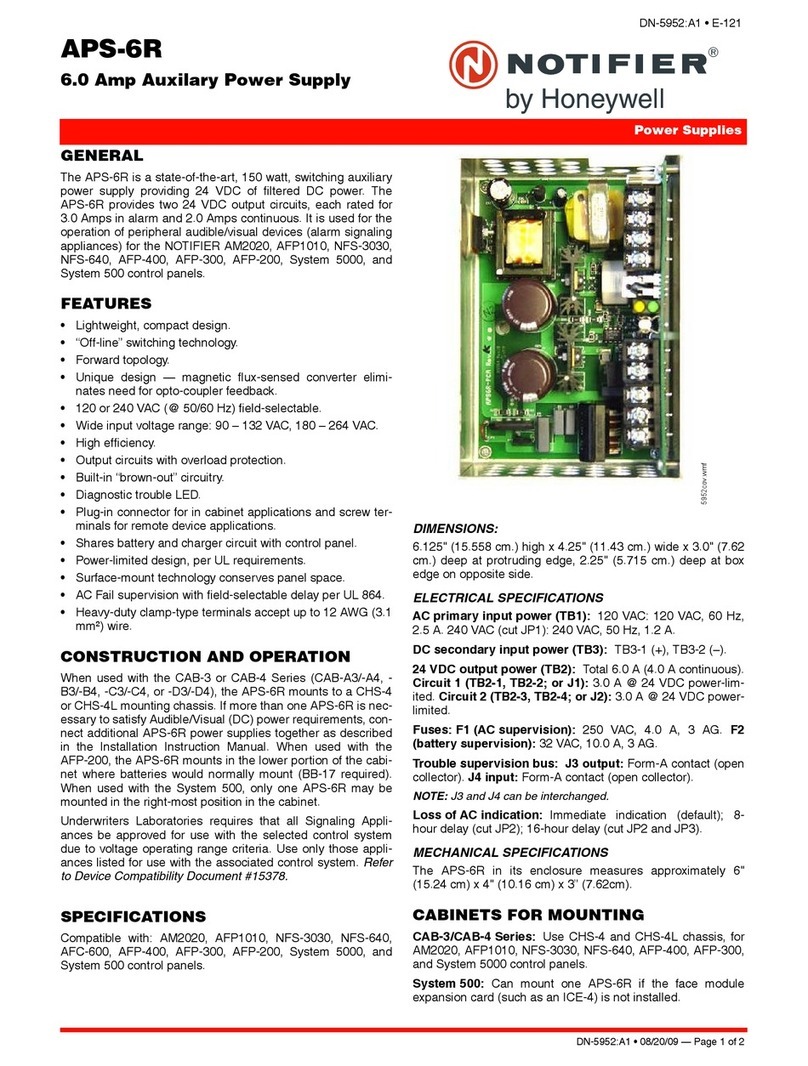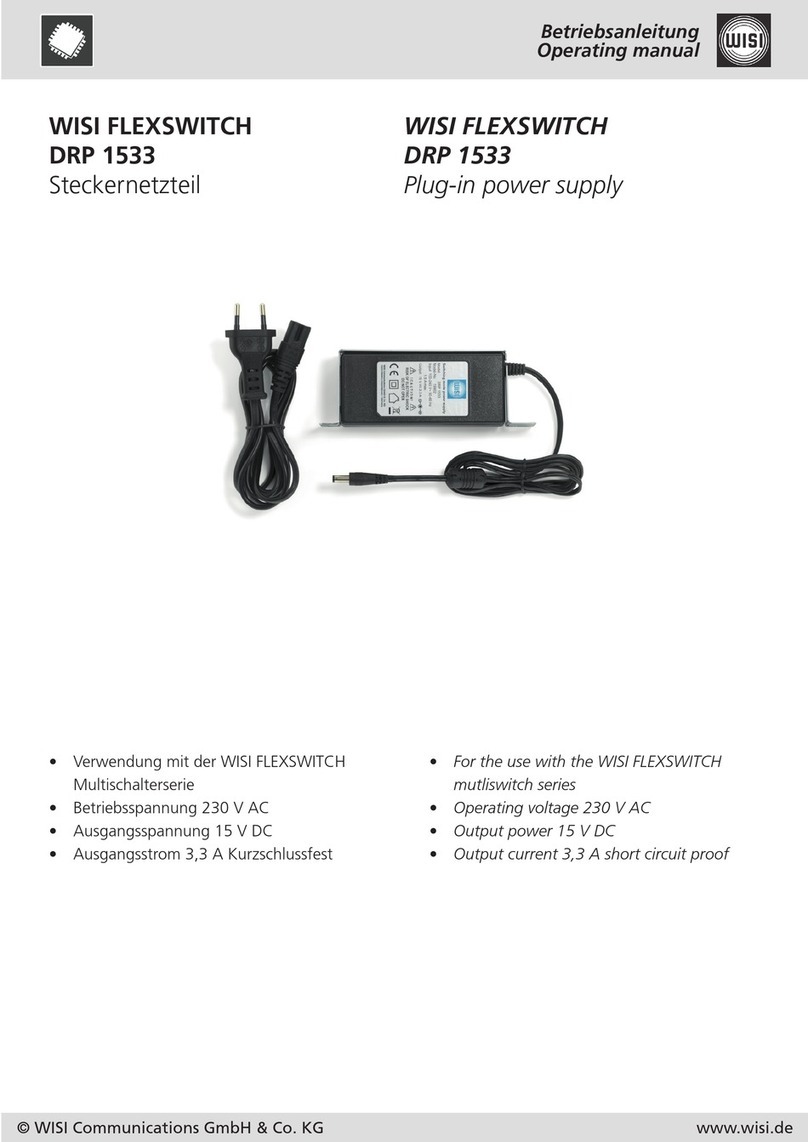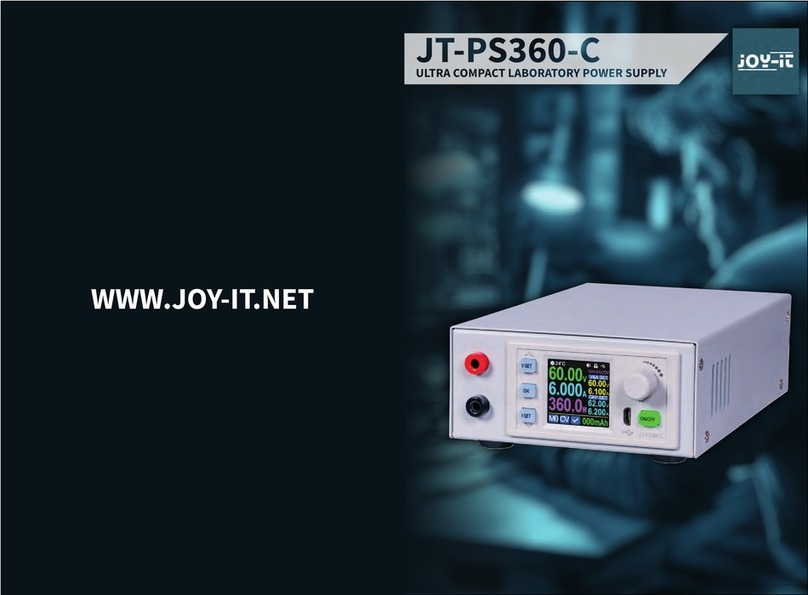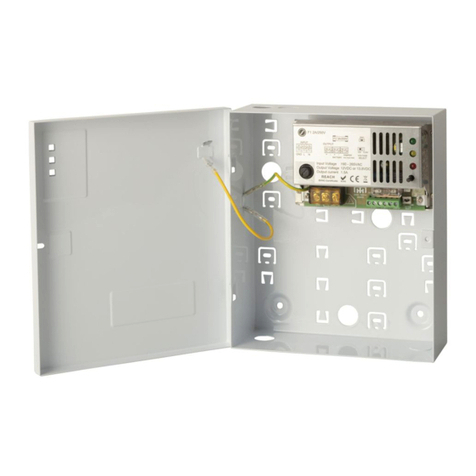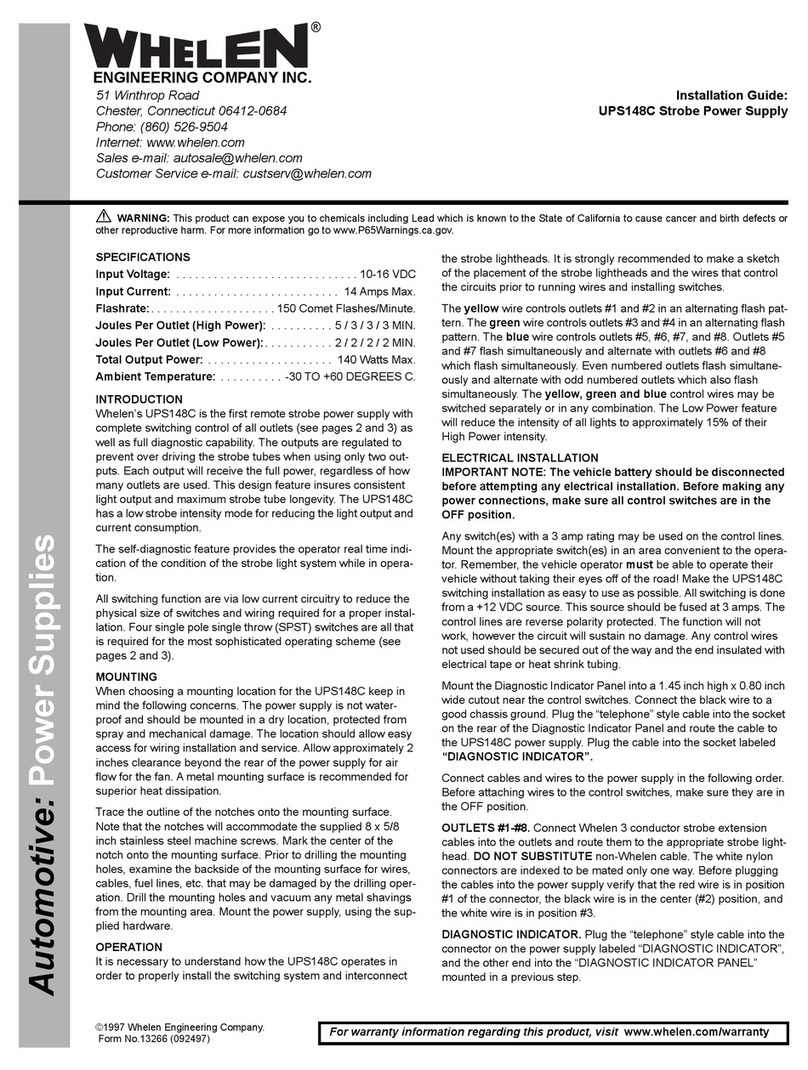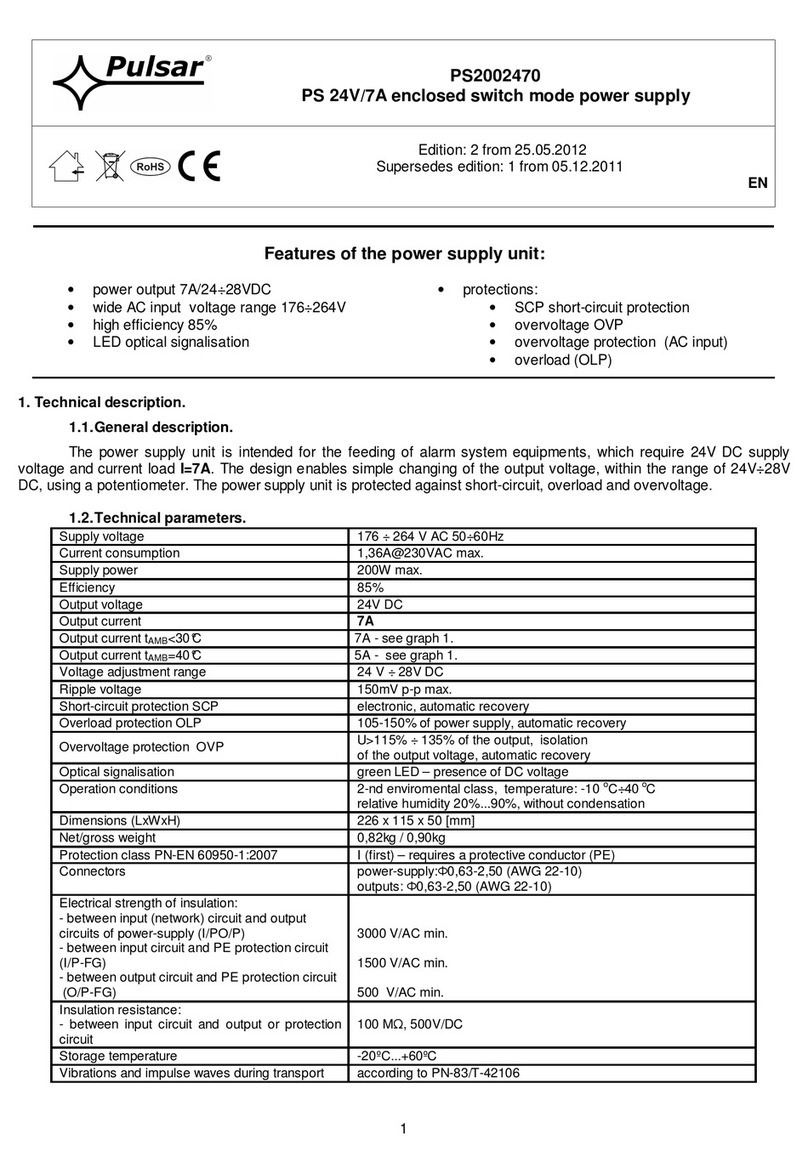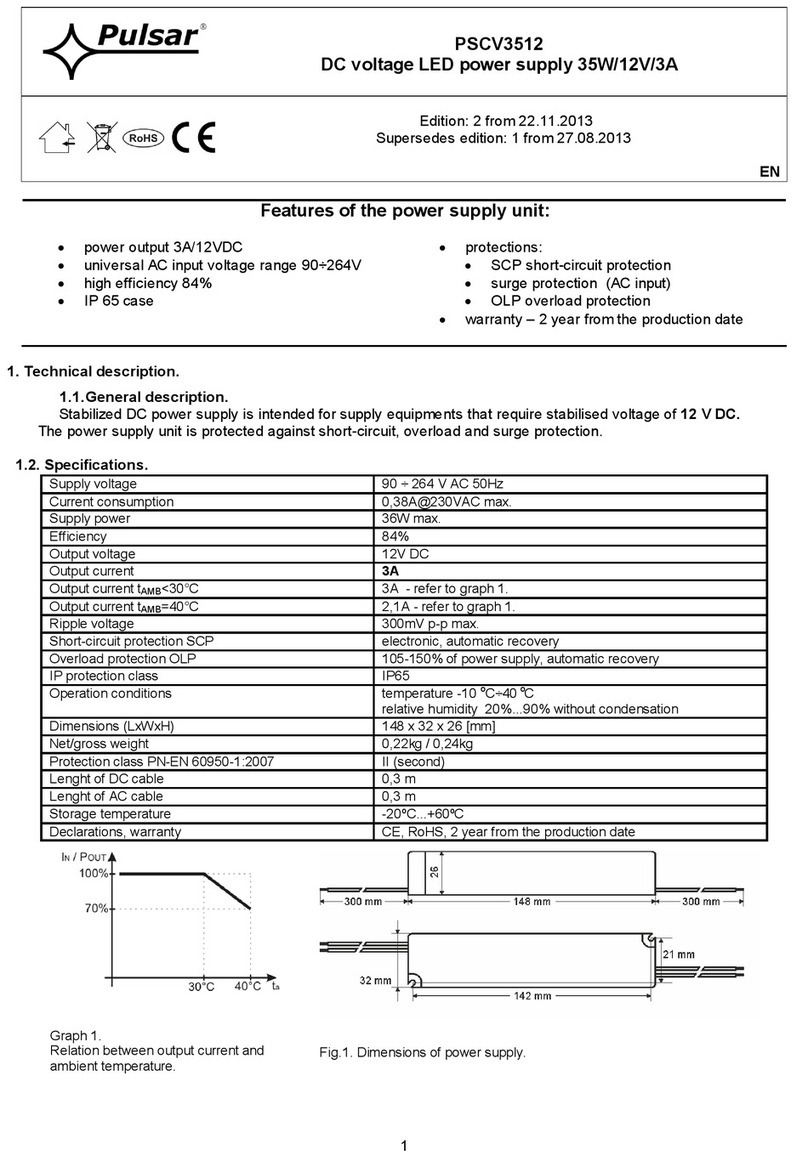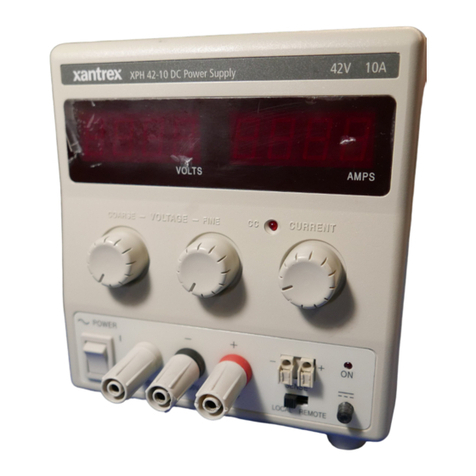Stanford Research Systems PS310 User manual

SERIES PS300
HIGH VOLTAGE
POWER SUPPLIES
MODEL PS310
MODEL PS325
MODEL PS350
1290-D Reamwood Ave.
Sunnyvale, CA 94089 U.S.A.
Phone: (408) 744-9040, Fax: (408) 744-9049
Copyright © 1998, 2000
Stanford Research Systems, Inc.
Al Rights Reserved
Revision 2.9
08/2004


1
TABLE OF CONTENTS
Safety and Preparation for Use 3
Series PS300 Specifications 5
Instrument Overview
Front Panel Summary 7
Power Button 7
High Voltage Enable Switch 7
LED Displays 7
Select, Enter, and Clear 7
Numeric and Cursor Keys 8
Instrument Status 8
Other Keys 8
Store and Recall 8
Rear Panel Summary 9
Power Entry Module 9
High Voltage Output Connector 9
High Voltage Polarity Selector 9
Analog Outputs 9
IEEE-488 Port 10
Guide to Operation
Setting Output Voltage 11
Setting Voltage Limit 11
Setting Current Limit 11
Setting Current Trip 11
Primary Trip 11
Reset Mode 11
Store and Recall 12
Error Messages 12
Analog Programming and Monitor 12
Default Setup 12
Guide to Programming
Remote Programming 13
Command Syntax 13
Detailed Command List 13
Output Control Commands 13
Setting Control Command 14
Interface Control Commands 14
Status Reporting Commands 15
Status Reporting 15
Serial Poll Status Byte 15
Standard Event Status Byte 16
GPIB Error Messages 16
Program Examples 17
Example 1 - IBM PC, Microsoft Basic,
Via Capitol Equipment Corp GPIB 17
Example 2 - IBM PC, Microsoft C 4.0,
Via Capitol Equipment Corp GPIB 19
Example 3 - IBM PC, Microsoft C 4.0,
Via National Instruments GPIB 21
Troubleshooting
Power On Reset 23
Stuck Keys 23
No High Voltage 23
Repeated Trips 23
Rear Panel Voltage Set 23
Front Panel Test 23
Calibration 24
Circuit Description
Introduction 25
Voltage Control 25
Low Voltage Pre-Regulator and
High Frequency Inverter 25
Limits and Trips 26
A/D's and D/A's 26
Microprocessor Control 26
GPIB and Front Panel Interface 26
Low Voltage Power Supplies 27
Front Panel 27
High Voltage Section 27
Component List
Main Board 29
Front Panel 35
HV Board - PS310, PS325, PS350 36
Miscellaneous Parts 40
Schematics
Voltage Control 1/11
High Voltage Drive 2/11
Limits and Trips 3/11
Analog Voltages and A/D 4/11
Microprocessor Section 5/11
GPIB and Front Panel 6/11
Low Voltage Power Supply 7/11
HV Front Panel 8/11
Model PS310 - 1250 V, 20 mA 9/11
Model PS325 - 2500 V, 10 mA 10/11
Model PS350 - 5000 V, 5 mA 11/11

2

3
SAFETY AND PREPARATION FOR USE
**********WARNING **********
This unit contains hazardous high voltages.
Please make certain that the high voltage is
completely discharged before removing the high
voltage cable. High voltage cables can store
charge if they are disconnected from the supply
while the high voltage is on. The charge on
the cable can cause injury or damage even after
the cable is disconnected from the unit.
Do not change the high voltage polarity unless
the power is off.
***********CAUTION **********
This instrument may be damaged if operated
with the LINE VOLTAGESELECTOR set for
the wrong AC line voltage or if the wrong fuse is
installed.
Line Voltage Section
The PS300 series operates from 100, 120, 220 or
240 Volts nominal AC power source with a line
frequency of 50 or 60 Hz. Before connecting the
power cord to a power source, verify that the
LINE VOLTAGE SELECTOR card, located in
the rear panel fuse holder, is set so the correct
AC input voltage is visible.
Conversion to other AC input voltages requires a
change in the fuse holder voltage card position
and fuse value. Disconnect the power cord, open the
fuse holder cover door, and rotate the fuse-pull lever
to remove the fuse. Remove the small printed circuit
board. Select the operating voltage by orienting the
printed circuit board. Press the circuit board firmly
into its slot, so the desired voltage is visible. Rotate
the fuse-pull lever back into its normal position.
Insert the correct fuse into the fuse holder.
Line Fuse
Verify that the correct line fuse is installed before
connecting the line cord. For 100 V / 120 V, use a 1
Amp fuse and for 220 V / 240 V, use a 1/2 Amp fuse.
Line Cord
The PS300 series use a detachable, three-wire power
cord for connection to the power source and to a
protective ground. The exposed metal parts of the
instrument are connected to the outlet ground which
provides protection against electrical shock. Always
use an outlet which has a properly connected
protective ground.
Connection to Other Instruments
The back panel BNC shields are connected to the
chassis ground and the AC power source ground via
the power cord. Do not apply any voltage to the
shield. The high voltage SHV connector is also
connected to the chassis ground and CANNOT be
floated away from ground.


5
SERIES PS300 SPECIFICATIONS
General Information
The PS300 series are programmable precision high voltage power supplies for use in laboratory or test
applications. They feature reversible polarity, excellent regulation and low output voltage ripple. The digital
displays provide accurate readings of voltage and current. Also, digital entry of the current and voltage
provides accurate resettability. Output voltage can be set from either the front panel, the remote analog voltage,
or over the optional GPIB interface. Voltage and current signals are also available for remote monitoring.
Electrical Specifications
Model Output Voltage Maximum Output Current
PS310 50 to ±1250 Volts 20 mA
PS325 50 to ±2500 Volts 10 mA
PS35050 to ±5000 Volts5 mA
Voltage Set Accuracy 0.01% + 0.05% of full scale
Voltage Display Accuracy V Set Accuracy ±1 Volt, typ ( ±2 Volt, max)
Voltage Resolution 1 Volt (set and display)
Voltage Resettability 1 Volt
Voltage Limit Range 0 to 100% of full scale
Voltage Regulation (*) Line: 0.001% for ±10% line voltage change
Load: 0.005% for 100% load change, typ
Output Ripple < 0.0015% of full scale, Vrms, typ
< 0.002% of full scale, Vrms, max
Current Limit and Trip Range 0 to 105% of full scale
Current Set accuracy 0.01% + 0.05% of full scale
Current Resolution PS310: 10 µA
PS325: 10 µA
PS350: 1 µA
Current Display Accuracy PS350: I Set Accuracy ±1 µA, typ ( ±2 µA, max)
PS325 or PS310: Accuracy ±10 µA, typ ( ±20 µA, max)
Stability 0.01% per hour, < 0.03% per 8 hours
Temperature Drift 50 ppm / °C, 0° to 50° C, typ
Protection Arc and short circuit protected; programmable voltage and
current limits and current trip.
(*) Regulation specifications apply for > 0.5% (full load) or 1.0% (no load) of full scale Voltage.
Below these values the unit may not regulate correctly.

6
Recovery Time 12 ms for 40% step change in load current, typ
Discharge Time <6 sec (to < 1% of full scale voltage with no load, typ)
Trip Response Time <10 µs
Minimum Trip Current 10 µA
Monitor Outputs Output Scale: 0 to +10 Volts for 0 to full scale output
regardless of polarity
Current Rating: 10 mA, max
Output Impedance: < 1 Ω
Accuracy:0.2%offullscale
Update Rate: 8 Hz
External Voltage Set Input Scale: 0 to +10 Volts for 0 to full scale output
regardless of polarity
Input Impedance: 1 MΩ
Accuracy:0.2%offullscale
Update Rate: 16 Hz
Output Slew Rate: < 0.3 sec for 0 to full scale under full load
Mechanical Specifications
Dimensions 16.0" x 8.1" x 3.5" (L x W x H)
The PS300 series are 1/2 rack width (19 inch standard rack). Optional rack
mounting kits are available for single or double rack mounts. The single
rack mount provides mounting for one supply. The double rack mount
provides side by side mounting for 2 supplies.
Weight 8 lbs
Input power 50 watts, 100, 120, 220, 240 VAC ±10%, 50 or 60 Hz
Output High Voltage Connector SHV male (Kings Type 1704-1 or equivalent, not included)
Mating High Voltage Connector SHV female (Kings Type 1705-14 or equivalent, not included)
Warranty One year parts and labor on materials and workmanship

7
INSTRUMENT OVERVIEW
Front Panel Summary
Power Button
The PS300 series are turned on by depressing the
POWER button. The unit always powers up with
the high voltage OFF. All instrument settings are
stored in nonvolatile memory and are saved when
power is turned off. The model number (310, 325,
or 350), firmware version, and serial number are
displayed when power is turned on. If an error
appears on power on, then the stored settings were
lost and the default settings are used. If the default
settings are desired, hold down the CLR (clear) key
while turning on the power.
High Voltage Enable Switch
This is a three position switch that performs several
functions. In the down position, the high voltage is
off and all trips are cleared. In this position the
high voltage is locked OFF and cannot be turned
on by computer control. The up position is
momentary and turns on the high voltage for
manual or rear panel analog control. In the middle
position the high voltage is enabled (but not
necessarily on) and can be turned on by computer.
The large red LED above the switch indicates that
the high voltage is on; the yellow LED below it
indicates a trip has occurred.
LED Displays
The two large displays show output voltage and
current to four significant places. Polarity is
displayed on the left of the voltage display. The
smaller center display shows the value of the
parameter that is being entered or adjusted. That
parameter is indicated by the row of LEDs directly
below the center display.
Select, Enter, and Clear
The SELECT key is used to choose which
parameter is being displayed in the center display.
The ENTER key enters the parameter shown in the
center display. The clear (CLR) key erases the
value in the middle display and recalls the last
value that was entered. To adjust a value, the
SELECT key is pressed until the appropriate LED
is lit. When the value is being changed, that LED
will flash to indicate that the value in the center
display is not the current unit setting. If an
incorrect value is entered, press CLR (clear) to start
over. When the desired value is in the center
display, pressing the ENTER key updates the unit's
actual setting and stops the LED's flashing.

8
Numeric and Cursor Keys
All parameters may be adjusted using the cursor or
numeric keys. When using the cursors, the digit
being adjusted in the center display will flash. The
UP and DOWN keys increment and decrement the
digit. The LEFT and RIGHT keys select the
flashing digit. When using direct numerical entry,
simply press the number and decimal point keys
until the desired value appears on the center
display. Note that the current is specified in mA.
Instrument Status
Three LED's indicate the instrument's status. The
LIMIT LED is on when the unit is in current limit.
REM is on when the front panel is locked out.
SRQ is on when a GPIB service request is pending.
Other Keys
RESET sets the reset mode to either AUTO or
MAN (manual).
GPIB displays the GPIB address in the center
display so it can be adjusted. It is also the LOCAL
key when the unit is in the remote mode.
Store and Recall
STO (store) and RCL (recall) allow up to 9
complete instrument settings to be saved in
nonvolatile memory. RCL 0 recalls the default
settings.

9
Rear Panel Summary
Power Entry Module
The power entry module is used to fuse the line,
select the line voltage, and block high frequency
noise from entering or exiting the unit. Refer to
the first page of the manual for instructions on
selecting the correct line voltage and fuse.
High Voltage Output Connector
WARNING: This unit contains hazardous
voltages. Please make certain that the high voltage
is completely discharged before removing or
connecting the high voltage cable. High voltage
cables can store charge if they are disconnected
from the supply while high voltage is present
which can cause injury or damage the unit.
The high voltage output connector is an SHV male
connector (Kings type 1704-1). Please make
certain that the high voltage is completely
discharged before changing the cable.
A 10 feet SHV-SHV or SHV-MHV cable is
available from SRS.
High Voltage Polarity Selector
WARNING: The unit must be turned off and the
high voltage should be completely discharged
before reversing the polarity. Failure to do this can
cause injury or damage the unit.
Polarity is indicated by the screwdriver slot on the
polarity switch as well as on the front panel's
voltage display. To reverse the polarity, turn the
unit off and allow the high voltage to completely
discharge. Then turn the polarity switch with a
large flathead screwdriver (clockwise for + to - and
counterclockwise for - to + ).
Analog Outputs
The two BNC's provide voltage and current
monitor signals, or an external voltage set and
current monitor. When the voltage select switch is
in the MON (monitor) position, both are 0 to +10
Volt outputs corresponding to 0 to full scale. When
the voltage select switch is in the SET position, the
current signal acts the same, but the voltage BNC
is an input, setting the the high voltage over the
same scale. When the switch is in the SET position,
the REAR LED on the front panel is lit, indicating
that the high voltage is under analog control and
cannot be adjusted from the keypad. All signals are
positive voltages, independent of output voltage
polarity.

10
IEEE-488 Std Port (optional)
The 24 pin IEEE-488 (GPIB) connector allows
computer control of PS300 series supplies. The
address is set from the front panel using the GPIB
key.

11
GUIDE TO OPERATION
Setting Output Voltage
The voltage set can be changed with the high
voltage on or off.
To set the high voltage output, press the SELECT
key until the VOLTAGE SET LED is lit. The
present value of the set voltage will be displayed in
the center window. To change the value, enter the
desired voltage by either the numeric or cursor
keys. After the new value has been entered into the
center display, press ENTER to update the output
voltage. The VOLTAGE SET LED will flash until
ENTER or CLR is pressed to remind you that the
displayed value is not the actual programmed
value. If an 'Err2' message appears (illegal
parameter entered), check the voltage limit to see
that it is greater than or equal to the desired set
voltage. Use the CLR key to clear any error
message.
If the REAR LED is lit, the high voltage is
programmed from the analog set input on the rear
panel. In this mode, when the center display is
showing VOLTAGE SET, the display is the
present programmed value of the high voltage and
cannot be adjusted from the front panel.
Setting Voltage Limit
The voltage limit is a protection feature to prevent
the output voltage from being set too high or
overshooting because of dramatic load changes.
The output voltage cannot be set higher than the
voltage limit. In addition, if the output ever
exceeds the limit by more than 10% of full scale,
the unit trips and the high voltage is disabled. If
this occurs, a 'VTRP'(voltage trip) message appears
in the middle display.
After a trip it is not necessary to clear the trip
before turning the high voltage back on. If it is
necessary to change a parameter before turning the
high voltage back on, pressing CLR or putting the
high voltage switch in the off position will clear the
trip.
To set the voltage limit, press the SELECT key
until the VOLTAGE LIMIT LED is lit. The present
value of the voltage limit is displayed in the center
window. Change it with either the numeric or
cursor keys and press ENTER to update the actual
limit value. If an 'Err2' message appears (illegal
parameter entered), check to see that the output
voltage is less than or equal to the voltage limit.
Setting Current Limit
Current limiting varies the output voltage to limit
the output current to less than or equal to the
programmed current limit value. When the unit is
current limited, the LIMIT LED is lit.
The current limit is set in the same fashion as the
voltage limit, by SELECTing the present value on
the center window, changing it and then
ENTERing the new value.
Setting Current Trip
The current trip shuts off the high voltage when the
output current exceeds the trip value. The current
trip value is set in the same fashion as the voltage
and current limits. After a current trip occurs, the
'ITRP' (current trip) message will appear in the
middle display. Current trips are cleared in the
same fashion as voltage trips.
Primary Trip
A PTRP (primary trip) message will occur if the
current through the primary side of the high
voltage transformer and the switching MOSFET's
exceeds about 5.3 Amps. This feature is included
to protect the transformer and FET's. The trip level
is not user programmable and may be cleared in the
same manner as the voltage and current trips. If
repeated PTRP's occur, see the troubleshooting
section.
Reset Mode
The reset mode determines how the unit responds
after a voltage or current trip.
MAN (manual) Mode: The high voltage remains
off after a trip and requires that the operator turn it
back on.
AUTO (automatic) Mode: The unit waits until
the output voltage has fallen to 1/50 of its full scale
value and then turns the high voltage back on. This
is useful when dealing with loads that occasionally
short circuit but recover after removing the high
voltage.

12
Store and Recall
STO (store) and RCL (recall) allow up to 9
complete instrument setups to be saved. To store a
setup, press the STO key, followed by a number (1-
9) and then the ENTER key. To recall a setup,
press the RCL key, followed by a number (0-9) and
then the ENTER key. RCL 0 returns the setup to
the factory default. Whenever a setup is recalled,
the high voltage is turned off for safety. If an 'Err3'
(recall error) occurs, then that stored setup was lost
due to a memory error and must be re-entered.
Error Messages
The following error messages may appear in the
center display. The CLR key clears the errors.
Err1 Memory Error
Power on memory error of the unit's
last setup. Default setup is recalled.
Err2 Illegal Parameter Entered.
Err3 Stored Value Recall Error
The stored setup (from STO and
RCL) was lost.
Err4 Illegal Storage Address
STO 0 is reserved for default settings.
Err5 No GPIB Interface The unit does
not have the GPIB option so the
GPIB address cannot be set.
Err6 Syntax error over GPIB.
Err7 Illegal parameter entered over GPIB.
Parameter entered is out of range.
Err 8 GPIB Output queue full.
Analog Programming and Monitor
The rear panel voltage select switch determines
whether the output voltage is set from the front
panel or from the rear panel voltage input. If the
switch is in the MON (monitor) position, the front
panel will set the voltage. If the switch is in the
SET position, the rear panel voltage will set the
output voltage. When the switch is in the SET
position, the REAR (rear panel) LED is lit and the
output voltage being set by the rear panel is
displayed in the middle display when it is showing
VOLTAGE SET. The voltage limit is still active
and does not allow the rear panel voltage to set the
output above the voltage limit. If the rear panel
voltage is too high, the output voltage will stop at
the limit voltage.
Voltage Monitor/Set: When the Analog
Programming switch is in the MONITOR position,
the VOLTAGE BNC is a monitor output providing
0 to +10 Volts for 0 to full scale output regardless
of polarity. When the switch is in the SET position,
the BNC becomes an input over the same range.
An input of 0 to +10 Volts will program the high
voltage from 0 to full scale, regardless of polarity.
Current Monitor: This provides 0 to +10 Volts
out for 0 to full scale output regardless of the
output polarity.
If the switch position is changed while the high
voltage is on, the unit will shut the high voltage
off.
Default Setup
The factory default setup can be recalled by
pressing the CLR key while turning the unit on or
recalling setup 0 (RCL 0). The default setup is also
recalled after a power on memory error (ERR 1).
The default setups are shown below.
PS310 Voltage Set 0 V
Voltage Limit 1250 V
Current Limit 21 mA
Current Trip 21 mA
Reset Mode MAN
High Voltage OFF
GPIB Addr 14 (if applicable)
PS325 Voltage Set 0 V
Voltage Limit 2500 V
Current Limit 10.5 mA
Current Trip 10.5 mA
Reset Mode MAN
High Voltage OFF
GPIB Addr 14 (if applicable)
PS350 Voltage Set 0 V
Voltage Limit 5000 V
Current Limit 5.25 mA
Current Trip 5.25 mA
Reset Mode MAN
High Voltage OFF
GPIB Addr 14 (if applicable)

13
GUIDE TO PROGRAMMING
Remote Programming
The PS300 series High Voltage Power Supplies
may be remotely programmed via the GPIB (IEEE-
488) interface. Any computer supporting this
interface may be used to program the PS300.
The PS300 supports the IEEE-488.1 (1978)
interface standard. Additionally, it also supports
the required common commands of the IEEE-488.2
(1987) Standard. Before attempting to
communicate with the PS300 over the GPIB
interface, the PS300's device address must be set.
The address is set from the front panel by pressing
the GPIB key and using the up and down arrow
keys to set the address to any number between 0
and 30. Pressing the ENTER key then sets the
selection.
Command Syntax
Communications with the PS300 use ASCII
characters. Commands may be in either UPPER or
lower case and may contain any number of
embedded space characters.
A command to the PS300 consists of a four
character command mnemonic, arguments if
necessary, and a command terminator. The
terminator is a linefeed <lf> or EOI. No command
processing occurs until a command terminator is
received. Command mnemonics beginning with an
asterisk "*" are IEEE-488.2 (1987) defined
common commands. Commands may require one
or more parameters. Multiple parameters are
separated by commas ",".
Multiple commands may be sent on one command
line by separating them by semicolons ";". The
difference between sending several commands on
the same line and sending several independent
commands is when a command line is parsed and
executed, the entire line is executed before any
other device action proceeds. This allows
synchronization to be achieved using the
synchronization commands.
There is no necessity to wait between commands.
The PS300 has a 256 character input buffer and
processes commands in the order received. If the
buffer fills up, the PS300 will hold off handshaking
on the GPIB. Similarly, the PS300 has a 256
character output buffer to store output until the host
computer is ready to receive it. If the output buffer
fills up, it is cleared and an error reported.
The present value of a particular parameter may be
determined by querying the PS300 for its value. A
query is formed by appending a question mark "?"
to the command mnemonic and omitting the
desired parameter from the command. If multiple
queries are sent on one command line (separated
by semicolons, of course), the answers will be
returned in a single response line with the
individual responses separated by semicolons. The
default response terminator that the PS300 sends
with any answer to a query is a linefeed plus EOI.
All commands return integer results except as
noted in individual command descriptions.
Examples:
VSET1.0E3<lf> sets VSET to 1000 V
VSET?<lf> queries the value of
VSET
*IDN? <lf> queries the device
identification (query, no
parameters)
VSET100.0;VSET? <lf> sets voltage to 100 V
and queries the voltage
Detailed Command List
The four letter mnemonic in each command
sequence specifies the command. The rest of the
sequence consists of parameters. Multiple
parameters are separated by commas. Commands
that may be queried have a question mark ? in
parentheses (?) after the mnemonic. Commands
that may ONLY be queried have a ? after the
mnemonic. Commands that MAY NOT be queried
have no?.
Output Control Commands
HVOF
The HVOF command turns the high voltage OFF.
HVON
The HVON command turns the high voltage ON
provided that the front panel high voltage switch is
not in the OFF position. If the switch is in the OFF
position, the high voltage is left off and an

14
execution error is reported. This command also
automatically clears any voltage or current trips.
IOUT?
The IOUT? query returns the actual output current.
This is the same value as shown on the front panel
meter. Note: As with the front panel meters, this
value takes about a second to stabilize after a
change in current.
VOUT?
The VOUT? query returns the actual output
voltage. This is the same voltage as shown on the
front panel meter. The value returned is a floating
point value and includes the sign of the output
voltage. Note: As with the front panel meters, this
value takes about a second to stabilize after a
change in voltage.
Setting Control Commands
*RCL i
The *RCL command recalls stored setting i.
Setting 0 recalls the default settings. If the stored
setting is corrupted, an error is returned.
*SAV i
The *SAV command stores the present setup as
setting i. i may range from 1 to 9.
ILIM(?) x
The ILIM command sets the value of the current
limit to x. The value x is a floating point value with
the units of Amps (e.g. 1 mA = 1E-3). The ILIM?
query returns the current limit setting.
ITRP(?) x
The ITRP command sets the value of the current
trip to x. The value x is a floating point value with
the units of Amps (e.g. 1 mA = 1E-3). The ITRP?
query returns the current trip setting.
SMOD?
The SMOD? query returns the VSET setting mode.
The value 0 means that the voltage value is
controlled by the front panel setting, while the
value 1 indicates that the output is controlled by the
rear panel voltage control input. Note that the
setting mode may only be changed by setting the
rear panel switch.
TCLR
The TCLR command clears any voltage or current
trips.
TMOD(?) i
The TMOD command sets the trip reset mode. The
value i = 0 sets manual trip reset, while the value i
= 1 sets the trip reset mode to auto.
VLIM(?) x
The VLIM command sets the value of the voltage
limit to x where x is the value in Volts. The sign of
value x MUST match the PS300's polarity setting.
The VLIM? query returns the present VLIM
setting. As with front panel control, the VLIM
value must be greater than or equal to the VSET
value or an execution error will be returned.
VSET(?) x
The VSET command sets the value of the voltage
set to x if front panel control is enabled. If rear
panel control is enabled, an error is returned. The
value x is a number in the units of Volts and the
sign of the number MUST match the PS300's
polarity setting. The VSET? query returns the
current VSET value. As with front panel control,
the VSET value must be less than or equal to to
VLIM value or an execution error will be returned.
Interface Control Command
*RST
The *RST common command resets the PS300 to
its default configurations. It is the same as holding
down "CLR " at power on.
*IDN?
The *IDN common query returns the PS300's
device configuration. This string is in the format:
StanfordResearchSystems,PS3XX,serial number,
version number, where XX is the particular model
number, "serial number" is the serial number of the
particular unit, and "version number" is the 3 digit
firmware version number.

15
Status Reporting Commands
*CLS
The *CLS common command clears all status
registers
*ESE (?) j
The *ESE common command sets the standard
status byte enable register. The parameter j is the
decimal value that the enable register is to be set to.
*ESR? {j}
The *ESR common command reads the value of
the standard status register. If the parameter j is
present the value of bit j is returned. Reading this
register will clear it. Reading bit j will clear bit j
only.
*PSC (?) j
The *PSC common command sets the value of the
power-on status clear bit. If j = 1, the power on
status clear bit is set and all status registers and
enable registers are cleared on power up. If j = 0,
the bit is cleared and the status enable registers
maintain their values at power down. This allows
the production of a service request at power up, etc.
*SRE (?) j
The *SRE common command sets the value of the
serial poll enable register. The parameter j is the
decimal value that the register is to be set to.
*STB? {j}
The *STB? common query reads the value of the
serial poll byte. If the parameter j is present the
value of bit j is returned. Reading this register has
no effect on its value. It is just the summary of the
other status registers.
Status Reporting
The PS300 reports on its status by means of two
status bytes: the serial poll byte, and the standard
status byte.
On power up, the PS300 may either clear all of its
status enable registers or maintain them in the state
they were in during power down. The action taken
is set by the *PSC command and allows things
such as SRQ on power up to be produced if
desired.
Serial Poll Status Byte
bit name usage
0 stable This indicates that the VSET or
ILIM value is stable. The value
depends on whether the PS300 's
in constant current or constant
voltage mode.
1 v trip This indicates that a voltage trip
has occurred.
2 itrip This indicates that a current trip
has occurred.
3 ilim This indicates that a current limit
condition has occurred.
4 MAV This indicates that the GPIB
output queue is non-empty.
5 ESB This indicates that an unmasked
bit in the standard status byte has
been set.
6RQS/ SRQBIT.
MSS
7 hvon This indicates that the high
voltage is on.
The PS300 will make a service request (SRQ)
whenever one of these bits is set AND the
corresponding bit in the serial poll enable register
is set. Note that any status condition will produce
only one SRQ even if it is never cleared. The vtrip,
itrip and ilim bits are latched bits. They are set on
the occurrence of the appropriate event and stay set
until either the status byte is read or the *CLS
command is sent. This allows one to detect if a trip
condition has ever occurred. All of the other bits
indicate the current states of their respective
functions.

16
Standard Event Status Byte
bit name usage
0unused
1unused
2 Query Error set by an output queue
overflow
3 Recall Err set if a stored setting is
corrupt
4 Execution Err set by an out of range
parameter, or non-
completion of some
command due to a condition
like overload
5 Command Err set by a command syntax
error or unrecognized
command.
6 URQ set by any key press
7 PON set by power on
This status byte is defined by IEEE-488.2 (1987)
and is used primarily to report errors in commands
received over the communications interfaces. The
bits in this register stay set once set and are cleared
by reading them or by the *CLS command. If a bit
in the standard status register is set and the
corresponding bit in the standard status enable
register is set, then the ESB bit in the serial poll
register is set.
GPIB Error Messages
The following error messages will appear on the
middle display if an error occurs due to a command
sent over GPIB:
Err6 Syntax Error over GPIB.
The command had an error in syntax or
was unrecognizable. A syntax error could
be a misspelling of a command or
forgetting to include a '-' when setting a
negative value for the voltage or voltage
limit. This error is the same as Command
Error, bit 5 of the Standard Event Status
Byte.
Err7 Illegal Parameter entered over GPIB.
A parameter was set out of range, or a
command could not be completed because
of an overload. This error is the same as
Execution Err, bit 4 of the Standard Event
Status Byte.
Err 8 GPIB Output Queue full.
The output queue overflowed and was
cleared. This could be due to querying the
unit repeatedly and not reading out all of
the characters, or a problem at the
recieving unit. This error is the same as
Query Error, bit 2 of the Standard Event
Status Byte.

17
PROGRAM EXAMPLES
This section lists example programs which use the GPIB port to control the PS300. All of the programs do the
same thing, only the language is different. The programs set up the PS300 to ramp the output voltage from 0 to
1000 Volts while reading the output current.
Program Example 1:
IBM PC, Microsoft BASIC, Via GPIB
This program requires the Capital Equipment Corporation GPIB card for the IBM PC. It has firmware in ROM
to interface high level languages to the GPIB.
Subroutine calls in Microsoft BASIC are done to memory locations specified by the name of the subroutine.
The address is relative to the segment address specified by the DEF SEG statement preceding the CALL.
In this program, the CEC card's ROM starts at C000H, the system controller's address is 21, and the PS300 is at
GPIB address 23. Make sure the address in the unit is set correctly and that the HIGH VOLTAGE ENABLE
switch is not OFF.
10 'EXAMPLE PROGRAM TO RAMP THE PS300 HV OUTPUT AND READ THE CURRENT
20 'USING IBM PC BASIC AND THE CAPITAL EQUIPMENT CORP.
30 'GPIB INTERFACE CARD
40 '
50 '
60 'SET THE PS300 GPIB ADDR=23
70 '
80 DEF SEG = &HC000 'BASE ADDRESS OF CEC CARD
90 INIT=0: TRANSMIT=3: SEND=9: ENTER=21 'ADDRESSES OF CEC FIRMWARE ROUTINES
100 ADDR%=21: SYS%=0 'CONTROLLER ADDRESS
110 PS300%=23 'PS300 ADDRESS
120 '
130 'STRING DEFINITIONS
140 IN$="IFC UNT UNL REN MTA LISTEN 23 SDC" 'CLEAR PS300
150 HV$="HVON" 'HV ENABLE
160 CR$="*RST" 'RESET PS300
170 IR$="IOUT?" 'READ CURRENT
180 VS$="VSET" 'SET HV OUTPUT LEVEL
190 '
200 '
210 CALL INIT(ADDR%,SYS%) 'INIT CEC CARD
220 CALL TRANSMIT(IN$,STATUS%): GOSUB 480 'CLEAR INTERFACE
230 CALL TRANSMIT(CR$,STATUS%):GOSUB 480 'RESET PS300
240 '
250 X=0 'INITIAL VOLTAGE=0
260 '
270 CALL SEND(PS300%,HV$,STATUS%): GOSUB 480 'ENABLE HV
280 '
290 X = X+10 'INCREMENT OUTPUT BY 10V
300 PRINT "VOLTAGE = "; X;
310 P$=VS$ + STR$(X) 'MAKE VSET COMMAND STRING
320 CALL SEND(PS300%,P$,STATUS%):GOSUB 480

18
330'
340 CALL SEND(PS300%,IR$,STATUS%):GOSUB 480 'QUERY CURRENT
350 ANS$=SPACE$(20) 'CLEAR RESULT STRING
360 CALL ENTER(ANS$,LENGTH%,PS300%,STATUS%):GOSUB 480 'READ CURRENT
370 N=VAL(ANS$) 'INTO VARIABLE N
380 PRINT " CURRENT = "; N 'PRINT VALUE
390 '
400 IF X<1000 THEN GOTO 290 'LOOP
410 STOP
420 '
480 'CHECK STATUS OF LAST GPIB COMMUNICATION FOR ERRORS
490 IF STATUS%=0 THEN RETURN 'STATUS OK
500 PRINT "GPIB ERROR STATUS CODE = ";STATUS% 'ELSE ERROR
510 STOP
This manual suits for next models
3
Table of contents
Other Stanford Research Systems Power Supply manuals
